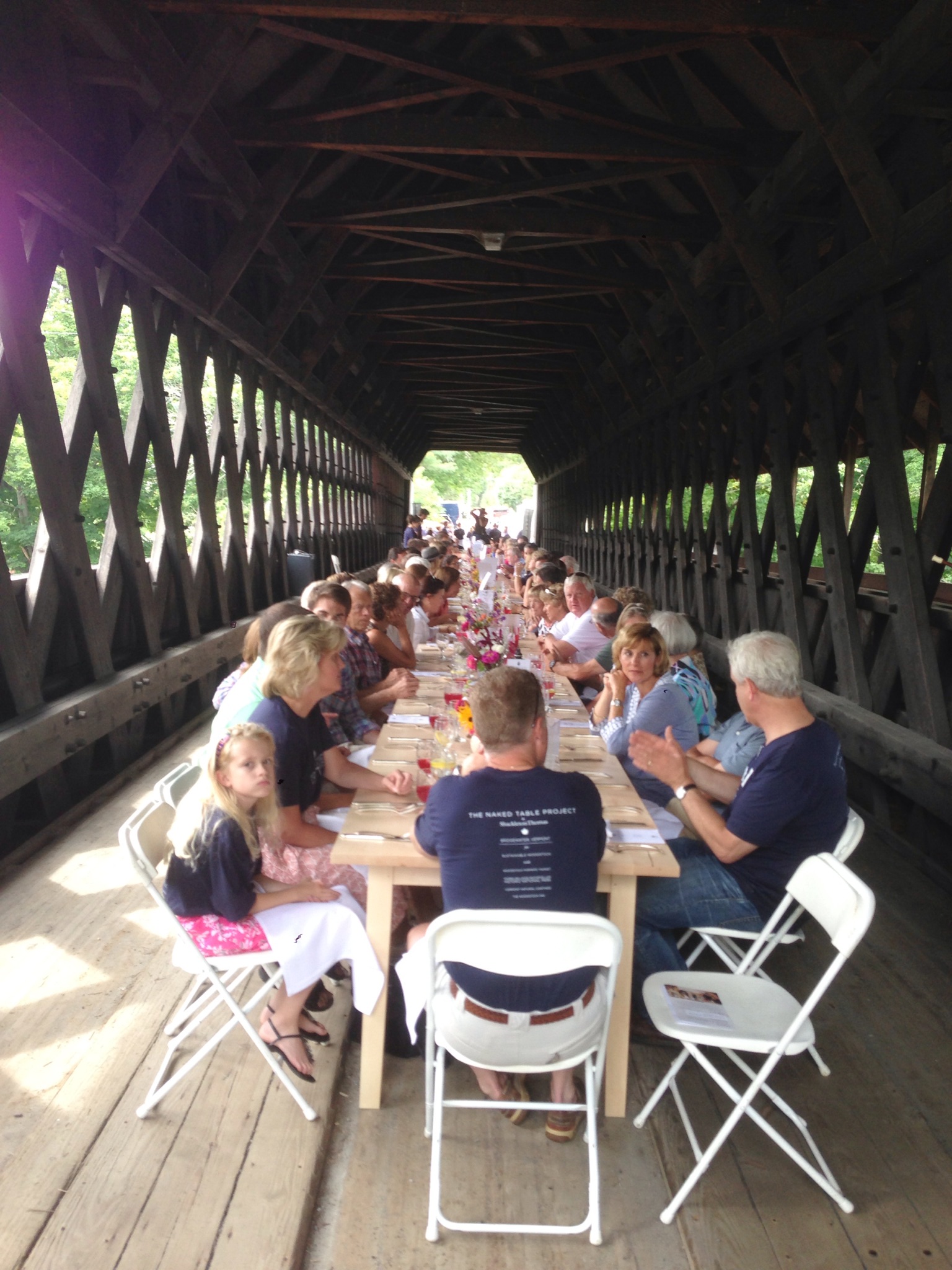This past weekend, I participated in a remarkable program that combines furniture making with an effort to educate about sustainability. The program is called the Naked Table Project, begun five years ago by Charles Shackleton, furniture maker and co-founder of Shackleton Thomas in Bridgewater, Vermont. Called Charlie by all who know him, Shackleton is a living history lesson himself, being a relative of famous Antarctic explorer, Sir Ernest Shackleton. Born in England and raised in Ireland, he has always understood the clear relationship between people and nature, and in the ways we use it. A skilled glassblower himself, Shackleton immigrated from Ireland to Vermont in 1981 with the now well-known glassblower, Simon Pearce, and spent five years with him in his shop in Quechee, Vermont before starting his own furniture making business.
In 2008, Shackleton created Naked Table to help connect everyday folks to the consumer goods they purchase. The concept of the term Naked Table is that the wood is enough. With minimal finish, the wood is resilient, beautiful, and gets better with age. He sources the wood for the tables from the forests of Marsh Billings Rockefeller National Historical Park, located in Woodstock, Vermont. The Park was the birthplace of conservation in the United States, and was donated by the Rockefeller family to be maintained as a sustainable operation. Shackleton works with the foresters, ecologists, and loggers to responsibly source wood from sugar maple trees in the forest, uses a local saw mill to cut and dry the wood, then mills the parts for the tables with local craftsmen as well as those working in his shop.
The weekend begins with Shackleton expressing his vision for a sustainable world with an emphasis on being a localvore: that is, sourcing products, food, and services from each area in which we live. Doing so creates more jobs and a better local economy, is more environmentally responsible, and reduces the use of carbon in our everyday lives. During his morning talk, Shackleton quoted a remarkable number, at least to me: for every table made in Asia and sold through some big box store, 11 tons of carbon are released. A Naked Table, locally sourced and built, releases .1 ton of carbon. He believes that global sourcing of cheap goods is actually stealing from our grandchildren, an assertion that makes sense to me.
After the talk and meeting other "tablemakers," we started to work in Shackleton's shop. This is real furniture from real sugar maple, which is beautiful, but heavy. Assembly and finishing is a two-person job, and I was joined by a good friend who was visiting from Houston, Todd Waite. There was sanding, gluing, assembly with wooden pegs, more sanding, then finishing. Lots of finishing. I was really glad to have Todd with whom to collaborate on our table, and to look over my shoulder to keep me from making mistakes. By lunchtime, our table bases were assembled, and several coats of a whey-based poly coating had been applied. A quick lunch, and off to Billings Farm for a tour of the forest where our wood had been harvested almost a year ago. In the meantime, our "table fairies" (Shackleton's shop supervisors and workers) would spend the next couple of hours inspecting and correcting any mistakes they might find in our work.
At Billings Farm, we were accompanied on our walk into the forest on Mt. Tom by the park's ecologist, Kyle Jones, and the forester, Benn Machin, who spoke about the park's history and unique ecology. They spoke of responsible forestry, and the use of trees taken from the forest for everything from firewood to fine furniture. The amazing part of this particular forest is that if simply left alone after trees are taken, native trees, more hardy than those that may have been imported, voluntarily sprout and begin to grow. Providing a healthy environment, especially with sunlight, allows young trees to come in and survive. Once in the grove where the wood for our tables had been harvested the previous autumn, we met the logger, Ben Canonica, who demonstrated felling trees and removing them with a two horse team that minimizes damage to the delicate forest floor. We completed our day back at Shackleton's shop, installed the table tops, and applied more coats of finish before calling it a day.
 The next day was very special. The Naked Table Project, along with Sustainable Woodstock (a sustainability organization locally run by town residents) arranged for a lunch on the Middle Bridge, a classic New England covered bridge in the heart of Woodstock. All of our brand new tables had been arranged right down the center of the bridge. About 100 people attended, including all of the tablemakers and their families. The local organic store, Woodstock Farmers Market, provided the food, and Sustainable Woodstock provided all the volunteers. The lunch was complete with a bag piper who walked the bridge during the entire event playing various highland instruments.
The next day was very special. The Naked Table Project, along with Sustainable Woodstock (a sustainability organization locally run by town residents) arranged for a lunch on the Middle Bridge, a classic New England covered bridge in the heart of Woodstock. All of our brand new tables had been arranged right down the center of the bridge. About 100 people attended, including all of the tablemakers and their families. The local organic store, Woodstock Farmers Market, provided the food, and Sustainable Woodstock provided all the volunteers. The lunch was complete with a bag piper who walked the bridge during the entire event playing various highland instruments.
I was very fortunate to sit next to Vermont's Commissioner of Forests, Parks, and Recreation, Michael Snyder, who was standing in for Governor Peter Shumlin, and who was our keynote speaker. Snyder himself is a forester, and during his remarks, he echoed the theme of sustainable use of our forests, mentioning that fully one-third of all schools in Vermont are heated with wood, a higher percentage than any state in the nation. He also coined a phrase that has stuck with me,
There is only a one letter difference between the words 'wood' and 'food'.
I found the whole Naked Table experience very rewarding and inspiring. My wife, Gracie, had built her own table a couple of years ago, and raved about the program. I now understand her and other participants' enthusiasm, which is born from Shackleton's own commitment to, and advocacy of, sustainable use of resources. I've probably gotten a little carried away with the whole concept, having decided to make Naked Table #182 my own personal desk, and I've got it in my shop at this moment with yet another coat of table top finish drying. One more coat, and it will be perfect.
The more you work it, and the more you use it, the more beautiful wood becomes. Now there's a life lesson; at least for me.
Photo by the author.
This post contains minor corrections from original post.
